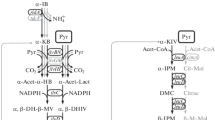Summary
Phenylalanine production from E. coli KA 197/pJN6 (plasmid harboring genes for aro F, phe AFBR, AmpR and TcR) was studied under varying nutritional conditions in batch and continuous cultures. In batch culture experiments where growth was deliberately interrupted by limiting concentrations of sulphate and phosphate the phenylalanine production continued from the non-growing cells. However, the depletion of phosphate resulted in an immediate cessation of phenylalanine production but thereafter a low specific rate of phenylalanine formation resumed, while the decrease in specific rate of product formation was less after sulphate depletion. In the chemostat experiments, however, phosphate limitation was the only case where the specific rate of phenylalanine formation remained constant, while at the corresponding time in sulphate and glucose limited chemostats it was declining respectively had ceased.
Similar content being viewed by others
References
Anderson Da Silva N, Bailey JE (1985) Theoretical growth yield estimates for recombinant cells. Biotechnol Bioeng XXVIII:741–746
Carrier MJ, Nugent ME, Tacon WCA, Primrose SB (1983) High expression of cloned genes in E. coli and its consequences. Trends Biotechnol 1:109–113
Dwivedi CP, Imanaka T, Aiba S (1982) Instability of plasmid-harboring strain of E. coli in a continuous culture. Biotechnol Bioeng 24:1465–1468
Förberg C, Enfors S-O, Häggström L (1983) Control of immobilized non-growing cells for continuous production of metabolites. Eur J Appl Microbiol Biotechnol 17:143–147
Förberg C, Häggström L (1985) Control of cell adhesion and activity during continuous production of acetone and butanol with adsorbed cells. Enzyme Microb Technol 7, May:230–234
Gil GH, Kim SR, Bae JC, Lee JH (1985) Pilot-scale production of L-phenylalanine from D-glucose. Enzyme Microb Technol 7, August:370–372
Harder W, Dijkhuizen L (1983) Physiological responses to nutrient limitation. Ann Rev Microbiol 37:1–23
Jones IM, Primrose SB, Robinson A, Ellwood DC (1980) Maintenance of some ColE1-type plasmids in chemostat culture. Molec gen Genet 180:579–584
Kleinman MJ, Gingold EB, Stanbury PF (1986) The stability of the yeast plasmid pJDB248 depends on the growth rate of the culture. Biotechnol Lett vol 8 no 4:225–230
Mizutani S, Fukuzono S, Tsukagoshi N, Udaka S, Kobayashi T (1985) Stability of a recombinant plasmid containing α-amylase gene in a chemostat. J Chem Eng of Japan vol 18 no 3:220–224
Skogman SG, Nilsson J (1984) Temperature-dependent retention of a tryptophan-operon-bearing plasmid in Escherichia coli. Gene 31:117–122
Author information
Authors and Affiliations
Rights and permissions
About this article
Cite this article
Förberg, C., Häggström, L. Effects of cultural conditions on the production of phenylalanine from a plasmid-harboring E. coli strain. Appl Microbiol Biotechnol 26, 136–140 (1987). https://doi.org/10.1007/BF00253897
Received:
Revised:
Issue Date:
DOI: https://doi.org/10.1007/BF00253897




